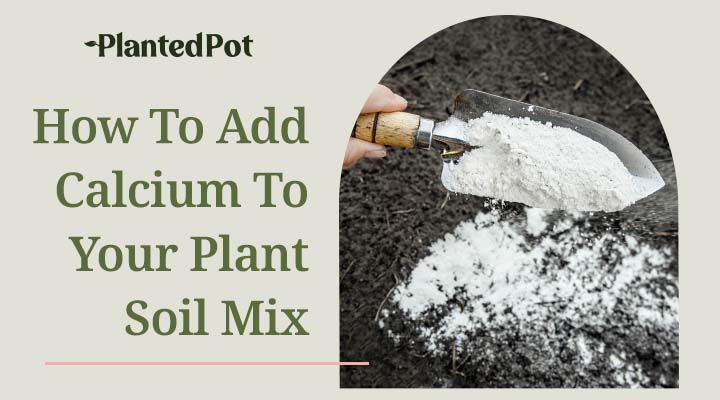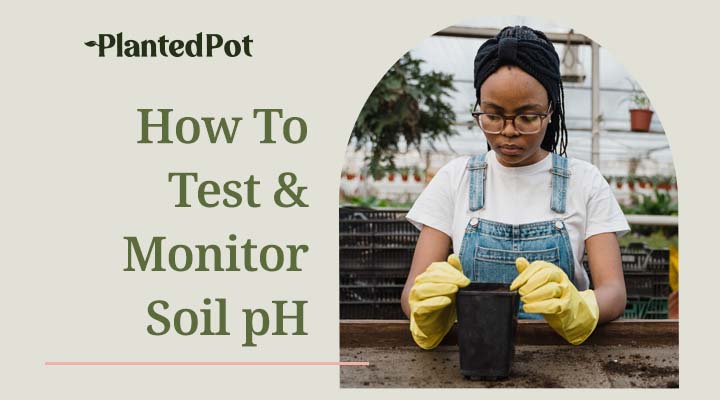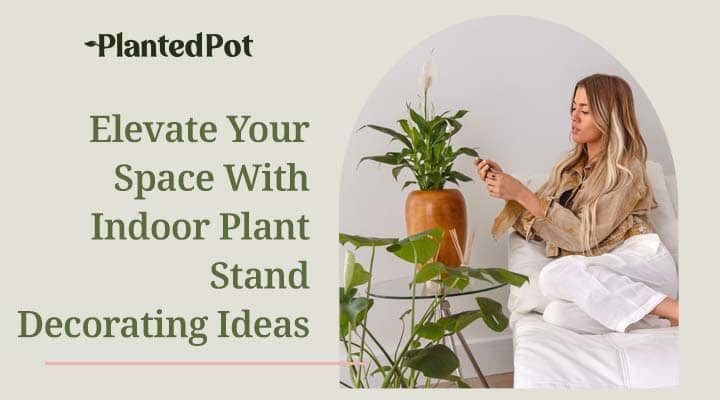
Watering Plants [Tips & Tricks For Watering Your Plants]
Home / Watering Plants [Tips & Tricks For Watering Your Plants]
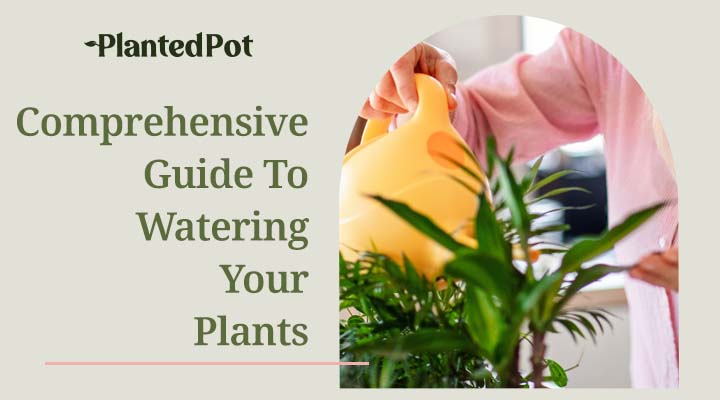
Watering Plants [Tips & Tricks For Watering Your Plants]
- Camilla Salas
- November 16, 2021
- 11:55 am
- No Comments
One of the best ways we as plant parents can care for greenery is through watering plants. Plants can reach for sunlight themselves, and there is an abundance of CO2 available in the atmosphere for them to take in, but water is something they can’t always get without our help. Watering your plants isn’t as simple as pouring a glass of water into your plant and then calling it a day.
Those who already have their green thumb developed know that different kinds of plants have different preferences, and it’s up to us to listen and cater to these needs. That’s why we’re here — to help you learn the why and how of plant-feeding so that you can start practicing the best ways to water your plants today!
Why Is It Important to Water Plants?
Just like humans, plants need water to survive. While we’re made up of about 60% water, plants are made of almost 90% water. They use a lot of water to stay hydrated, create energy, and keep themselves alive, which means they need it even more than we do.
The key to proper watering is figuring out how much each species needs to stay hydrated and photosynthesize. Different plants prefer different amounts. How much water your plant needs can depend on their size, preferred temperature and humidity, and preferred lighting.
Photosynthesis & Energy
Photosynthesis is a process where plants cultivate food and energy for themselves. They take CO2 and water, and using energy from the sun or other light sources to create a sugar called glucose. Glucose gives the plant energy to help it grow and any other life forms that may use the plant for food.
Without the proper amount of water to complete photosynthesis, plants cannot fulfill this process, halting their growth. This is why plants don’t survive for long if they’re given too little or too much water.
What Happens If You Overwater Plants?
Part of the reason why so many plants prosper in the soil is that it’s rich in water and oxygen, along with other nutrients. When plants are overwatered, their roots are unable to reach enough oxygen to survive, which has some nasty side effects:
- Yellowing, browning, and wilting of stems, leaves, and petals.
- Stunted growth prevents baby plants from maturing and thriving.
- Root rot disease can spread through wet soil, affecting smaller plants, foliage, trees, and more. This disease can occur when roots begin to die and rot within the soil. While it can be treatable, you must act quickly to catch it before it spreads.
- Drowning, which can occur when your plant’s roots are submerged in water for too long.
When soil moisture is too high, it can also grow mold and smell foul, which are good physical indicators that you are probably feeding your plant too often.
What Happens If You Underwater Plants?
Underwatering is just as bad for your plants as overwatering and can nip them in the bud just as quickly. Every plant requires different amounts of water, but a good indicator that your plant needs water is if the soil feels dry to the touch. Underwatering can cause:
- Stunted growth, which may prevent once healthy plants from flowering at all.
- Dry soil and wilting leaves that fall off prematurely.
- Crunchy stems that are unable to grow taller or support healthy leaves.
By regularly checking your plants’ soil with your finger, you’ll be able to tell when the soil is starting to dry out. This way you’ll have a better idea of when to add more water.
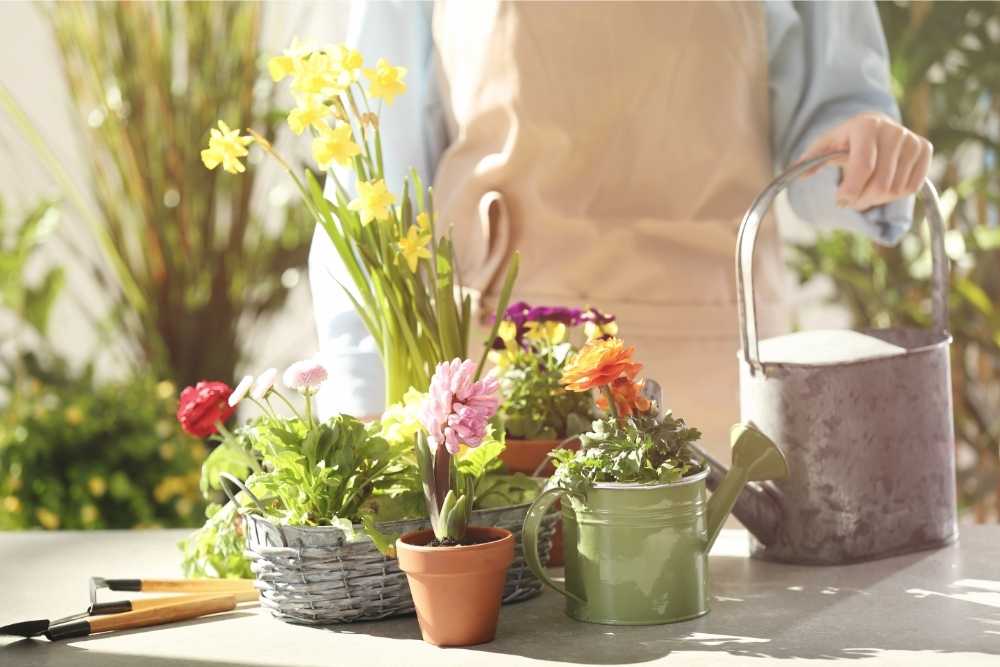
When Is the Best Time of Day For Watering Plants?
The best time of day to water most plants is usually in the very early morning or later in the afternoon, once the sun has set. If you’re currently only caring for indoor plants, this matters a little less. Since these live under our roof, we can control external conditions a bit more (like how hot or humid it is inside), affecting overall water intake.
Watering Cooler Soil is Cooler For the Environment
Watering the soil in the morning or later in the afternoon is often better for your plants. This is true for outdoor plants or potted plants that spend most of their time outdoors. This kind of watering schedule is also beneficial for the environment. Here’s why:
- Evaporation takes longer in cooler soil. Plants require less water during these times, instead of when the sun is at its peak in the middle of the day. Water conservation is great for the environment, especially in areas prone to experiencing droughts.
- Plants absorb and conserve water better during these hours. Because it takes water longer to evaporate in cooler soil, plants have more time to properly soak up the moisture. This means happier growth for your leafy friends.
- Bone dry or sunburnt? When you water your plants while the sun is at its peak, you’re at a higher risk of burning them. Plant leaves can be sensitive, and putting moisture directly on them when they’re already hot can be a recipe for disaster.
A Late-Night Dilemma
While it can be beneficial for you to water garden plants in the late afternoon, be cautious before you begin watering them at night. Watering plants too late can make them more susceptible to fungal infections, rot, drowning, and freezing in cooler seasons.
What Should You Use When Watering Plants?
Proper watering schedules can be tricky to figure out, but it shouldn’t be hard for you to get to watering. Many different products on the market can help you water various types of plants more efficiently so that you can save precious time while properly caring for your plant babies.
Hoses: Garden Hose vs. Soaker Hose
Did you know that there’s more than one kind of outdoor hose? Each has its benefits and special uses, so before you grab any random hose at the store, make sure that it’s the one that caters to your needs best.
Also, bear in mind that while hoses are great for outdoor watering, it can be a lot more complicated to water potted plants with a hose. It might also be harder to water indoors with a hose, too…
Garden Hoses
Garden hoses are generally meant to deliver water in one direction at a time. Unless you add a watering wand to the end (this is a long hose attachment that lowers water pressure and creates a shower of water that is gentle on your plant’s leaves), water will flow from a single, thick stream.
These hoses can be great for people looking for a multi-use hose — if you do a lot of outdoor housework or cleaning, this heavyweight hose may be the right one for you. However, if you only plan to use your hose to water plants, you might want to consider an alternative.
Since this hose is harder to manipulate and control (both physically because of weight and stream-wise), it can be more difficult to gauge how much water is getting used. It’s also less efficient than other hoses because you can’t easily manipulate how much water comes out of it.
Soaker Hoses
Soaker hoses are long hoses laid across the ground to slowly drip water along the soil. These are generally more efficient than gardening hoses for watering purposes because they were made specifically with your garden in mind. They have a slower drip, so they water more deeply and evenly without much external help.
Though they are more delicate in structure, they can be embedded within a flower bed or yard and are completely capable of watering your plants without you. They’re like tinier, personal versions of larger irrigation systems (think of how farmers water their crops), only much cheaper and easier to install.
While we love a hose that feels light in weight, this means that soaker hoses will break more easily than garden hoses. Soaker hoses usually aren’t great for much outside of watering. They’re also less precise since water doesn’t flow out of them in a direct stream.
Tools for the Bottom Watering Method
Bottom watering is a fantastic method for watering any potted plant because the roots can easily reach down to drink, and it’s super cheap too! If you have a large sink, or a large pot, water basin, or bucket, you can try this method out!
Place your plant into a large receptacle that’s half-filled, and let it soak for up to 30 minutes. Be sure to check the soil periodically with your finger to avoid drowning your plant.
Gradual Flow Devices: Watering Globes
Watering globes are great for plants and are even more awesome for people who have really busy schedules and often forget to water their plant pals. These gradual flow devices can be filled with water and stuck into the soil of any of your houseplants. They will slowly release water as it’s needed, keeping the soil level moist.
If your plant requires heavier watering, it may be smart to use multiple globes. You can also use them in combination with another technique so that you don’t accidentally underwater your plant. While globes are convenient, thirsty plants may need more moisture content to keep happy.
Watering Plants Indoors
Most houseplants can go without being watered for much longer since they’re not underneath direct sunlight. Plant parents have almost complete control of the environments they’re raised in!
How Often Do Indoor Plants Need Watering?
You should water your indoor plants need somewhere between once per week to once every three weeks. Though different houseplants require different amounts of water, younger buds and seedlings will always need more water than more mature plants since they still have a lot of growing up to do.
The amount of water your plant needs will also depend on their size, what kind of lighting they require, and their preferred temperature and humidity levels. Check out Planted Pot’s Plants section to learn more about specific plant friends’ preferences.
Watering Plants Outdoors
Whether in a container or the ground, outdoor plants generally need a lot more water than other household plants do. This especially holds for those who live in warmer climates, like California, Nevada, or Texas.
How Often Do Outdoor Plants Need Watering?
Outdoor plants that live in large pots, containers, or flower beds will need more watering than those in the ground. Higher temperatures lead to faster water evaporation rates. Many may need to be watered daily, depending on how hot it is — try adding small rocks on top of the soil surface to help it retain moisture outdoors.
Like indoor plants, outdoor plants’ needs will also vary based on their plant type requirements, especially if they live in containers. Plants who live in the ground, on the other hand, have vastly different needs. Most outdoor plants require a few inches of rainwater per week. You should water them weekly or biweekly if there’s not enough through rainfall.
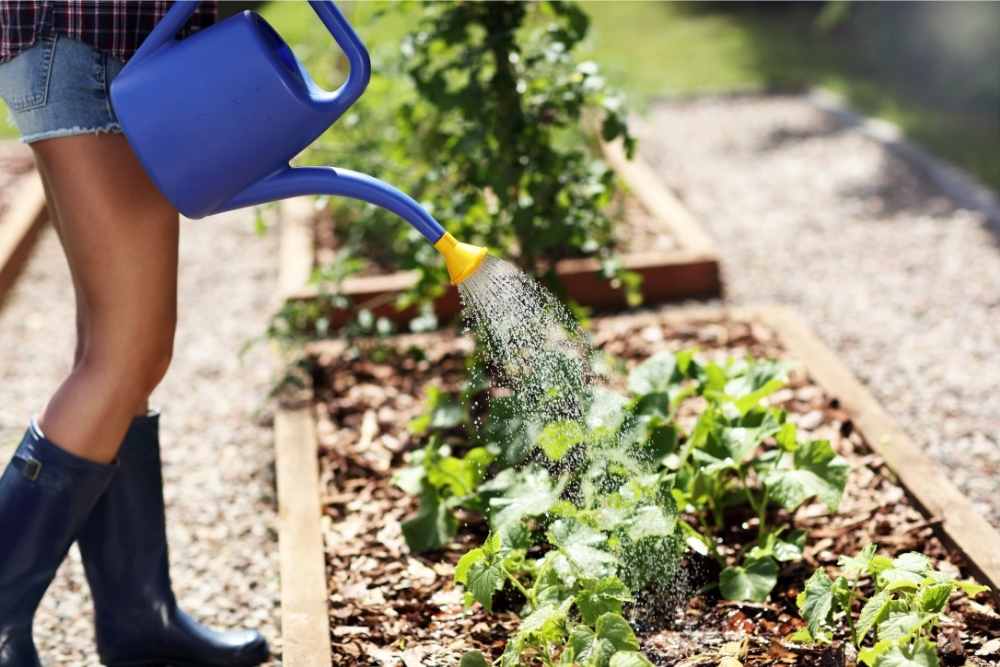
What To Consider When Watering Plants At Home
There are many variables to consider when watering plants at home and figuring different watering schedules:
- Are your plants outdoors all the time? If they are, they’ll likely need to be fed more often.
- Are they exposed to more rainfall than other plants? These will likely need less water than their counterparts.
- Are there signs you’re over or underwatering? It’s okay to adjust watering schedules and routines if it means keeping your plants healthy.
- Is my plant suffering outside in summer or winter weather despite how I water them? Try adjusting your friends’ locations if they don’t react well when seasons change and see if it helps.
- Does water quality matter when feeding my plant babies? Usually, distilled and filtered water is best for plants. Tap water is often treated and can be harmful to give to houseplants.
Have more questions? Check out Planted Pot’s Learn section for more tips and tricks that’ll help your little pals blossom into their best selves.
Final Thoughts – Watering Plants
Learning how to water your plants according to their needs can be difficult at first. But it’s worth it in the long run to watch your plant pals grow and flourish. Before you know it, you’ll have a beautiful paradise right at your fingertips, in your backyard, and throughout your home!


